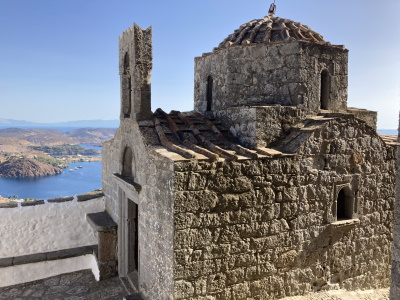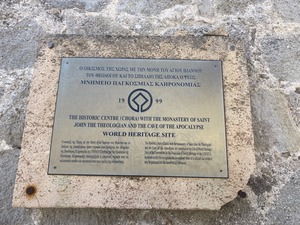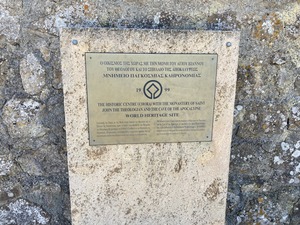Island of Patmos

The Historic Centre (Chorá) with the Monastery of Saint John "the Theologian" and the Cave of the Apocalypse on the Island of Pátmos represent a traditional Greek Orthodox pilgrimage centre.
The Cave of the Apocalypse is venerated by both Catholics and Eastern Orthodox as the place where St. John the Apostle had his visions around 95 CE. A fortified monastery dedicated to him was added in 1088. The associated settlement of Chorá dates from late medieval times and includes mostly 17th-century small churches and residential houses.
Community Perspective: Patmos Island is reachable by ferries from Rhodes, Mykonos and Samos, and a bus awaits for the uphill transfer to Chora. The sites can even be covered on a day trip, but when you stay overnight you can enjoy the rest of this pretty island.
Map of Island of Patmos
Community Reviews
Els Slots

Patmos I found the prettiest of the Greek-islands-with-a-WHS. It does particularly well on ‘views’: of the blue sea and the surrounding islands, of that little chapel against the blue sky, of its obligatory row of windmills. The three components of its WHS also look well cared for. Like the other islands, Patmos does see its fair share of cruise ships, anchoring in the bay outside of the harbour: in 2022, no less than 285 of them will arrive. Overall, I encountered many more 'regular' tourists than pilgrims, which took away a bit of the holy atmosphere of the island.
When you arrive at Patmos from the sea (there is no airport), you’ll immediately notice the large fortress on top of the highest mountain on the island. What looks like a castle is in reality the Monastery of St. John. It was only half past 11 when the boat delivered me, way too early to check in at the hotel. So I had a first look at the WHS. About once an hour there is a bus from the port town of Skala to Chora, the old town where the monastery is also located. The distance between them is only five kilometers, but it's a steep climb.
Many people visit Patmos as a day trip only from one of the other islands, so it is busiest around noon when the boats have arrived. Fortunately, I had two days here, so I saved the more popular sights for the other day when I could get an early start. First I wandered through pretty Chorá, a labyrinth of narrow streets and white stone houses where only the windows and doors have retained their natural color.
Then I walked down the mountain, back to Skala. Halfway through you will pass the Cave of the Apocalypse. This is the most sacred part of Patmos, said to be where the evangelist John had a vision about the end of the world around AD 95 and then penned it down in what later became a book of the Bible. Over the years, many buildings have been built around the cave, so it is initially unclear where to enter. The 'real' entrance is marked by a man selling entrance tickets (3 EUR each) and there is also a shop with pilgrim souvenirs. You go through a few more corridors, with an icon or two on the walls, and then you're in what really is "the" cave. There were a few people praying against the rock wall.
The next day I took the bus uphill again at half past eight. This time I was going straight to the monastery. There were no other visitors at this early hour except for a Greek woman and her daughter. After entering the fort and paying for your ticket, you first arrive at the church which opens into a small courtyard. The outer gallery of the church is covered with murals, but the best ones are kept inside (where unfortunately you are not allowed to take pictures). They fully cover the walls.
Another highlight of the monastery is the museum. It has a focus on icons, and many date from the time when Patmos became a safe haven for refugees from Crete fleeing the Ottoman Empire (early 17th century). That the Ottoman sultan also sometimes collaborated with the Orthodox Christians of Patmos, is apparent from an exhibited edict in which he calls for the return of 3 inhabitants of Patmos who had been kidnapped by pirates... From one of the windows of the museum, you have beautiful views of Chorá, the rest of the island of Patmos and the surrounding blue sea.
For the rest of the morning, I walked through the old streets again - in one of the streets there were no less than 13 cats lingering around! And I visited the nunnery Zoodohos Pighi, which also has a beautiful old church full of murals. From the recently restored row of windmills, you have good views of the fortress-monastery. We have these windmills included in one of our connections (Europa Nostra Award), however, I am not sure that they are in the core zone as they lie just outside of Chorá. As often, the official site map is terrible so I can't be sure and will give them the benefit of the doubt for now.
Read more from Els Slots here.
Tsunami
Japan / USA / Europe - 07-Jan-21 -

A hole in the rock wall that might shape our future
While visiting the island of Samos from the island of Chios in mid-October 2020, due to my time constraint I made only a day trip to the island of Patmos by ferry where I stayed only for 5 hours between 10:30 and 15:30.
The ferry departs from the port of Pythagorio, a WHS city, in Samos, so it is rather easy to combine visits to these two WHSs. The ferry ride, through some other islands, was about 2 hours.
I had to plan the time allocation carefully, especially because both the Monastery of Saint John the Theologian and the Cave of Apocalypse take an afternoon break between 13:30 and 16:00. So I had only 3 hours between 10:30 and 13:30 to visit the two. I took a taxi immediately after the ferry arrived at Skala, the main city of the island of Patmos, to the town of Chora where the Monastery is located.
The monastery is on top of the hill that is Chora and dominates the area. As I walked up from where the taxi dropped me off, I also saw several souvenir shops / stalls. The whole scene somewhat reminded me of Mon San Michel in France.
But the monastery created in the 11th century looks more like a castle / fortress than a religious compound. It probably signifies its special place in Christianity. The general public are allowed into only two interiors in the monastery, the main church and the museum, both of which are quite small, considering how large the whole imposing edifice is.
They were doing some sort of maintenance of the church that morning, so I went to the museum first. The 2-story museum certainly holds significant documents, icons and costumes, including the edict to create the monastery by the Byzantine emperor at that time.
While still waiting for the church to open up, I walked around in the exterior area within the edifice, taking several stairs up and down and peeking into living quarters where some monks seemed to live.
The church was even smaller than the museum and looked more like a single chapel, darkly lit, but richly decorated.
There was a restaurant open in Chora with crowds and with a nice view of the Aegean where I thought about having lunch. But then I found a bus to take for 2 km down to the Cave of Apocalypse, so I decided to forgo lunch there and took the bus instead to cut the time for walking for 2 km.
When I got off the bus, a cigarette-puffing, bearded Orthodox monk / guard led me to the cave church. This is supposed to be where St. John the Theologian inhabited and had the apocalyptic vision described in the Book of Revelation written by him. What appeared to be the iconostasis of the church had some colorful paintings, but the church is better known for the "pillow," a little hole on the rock wall where St. John rested his head when he slept (photo). It looked quite uncomfortable, and I thought if he had spent all day in the claustrophobic cave and slept with the pillow at night, it couldn't have been too difficult to have such a wild vision. He would have craved "light" for sure.
The Book is the basis for the belief of many US Republicans today, including a friend of mine, that the US Democrats are trying to allow immigrants from around the world into the USA, who go back and forth between the USA and their home countries, and then to establish one world government with their help, which is the beginning of the end of this world, as they interpret the Book. It is seriously interesting if the whole vision was caused by this pillow.
I walked down to Skala and still had 2 more hours until my return ferry departs, so I had lunch at one of the many restaurants that were open at the port area. I really liked the whole ambience in this small island and even had enough time to find and talk to the owner of a decent apartment near the port where I might come back to live for a few months in the near future.
Read more from Tsunami here.
John booth

Patmos Island is reachable by ferries from Rhodes, Mykonos and Samos. From the port of Skala buses travel up the steep winding road to Chora, location of the fortified monastery of St John.
Besides the distinctive architecture of the monastery, the frescoes are quite stunning, particularly those within the chapel.
On the descent by bus from Chora to Skala I stopped off to visit the cave of the Apocalypse, a detour involving descending and climbing several steep flights of steps.
Laura Barber
Patmos was a lovely, quaint town with very friendly people. the water there is not potable which I found surprising but the island was a gem. We were on a cruise that stopped there and we spent way too little time.
The monastery and cave were very well preserved. I toured both and just being somewhere where St. John had actually been was pretty awe inspiriing. Not enough is known of this small, beautiful and historic island and perhaps that is part of its' immense charm.
Iain Jackson
Isn't it surprising that,almost 12 years after inscription, this is the first review of this site? It isn't as though getting to Patmos is difficult; it can easily be fitted into a Greek island hopping trip (in my case after Samos and before Mykonos). Accommodation on the island is plentiful too.
The WHS doesn't include the whole island (which has an area of 34km2 and a population of about 3000) just an Old Town, a monastery and a cave. These can easily be seen in one day.
Approaching from the sea the Chora(the old town) is seen occupying the highest parts of the hill rising above the harbour with, at its summit, the monastery of St John, protected by massive walls.
On a warm and sunny day in October 2004 I was pleased to be offered a pillion ride up the winding road to the top of the hill. Many parts of the monastery are closed to the visitor. What can be seen consists of small rooms and the courtyards between them with lots of intriguing passageways. Close by the entrance is the main church; it is small, atmospheric and rather gloomy with many of the frescoes all but obliterated by centuries of candle smoke. The Treasury museum contains the customary plate, silverware etc and is particularly strong on books, manuscripts, codices and the like.
The Old Town is in some ways like a small Arab town with houses showing almost blank walls to the passer-by, though a number of tiny churches are squeezed in amongst the houses.
Part way down the hill is the cave in which John is said to have had his divine revelation and to have dictated his vision to his devoted scribes. The cave has been extended to form a small chapel. A notable feature is a circular recess(nowadays rimmed with a silver collar)in the stone wall of the cave, and in this John is said to have laid his saintly head to sleep.
Patmos has many attractions and this site should be of interest not just to WHS spotters. I look forward to another review.
Community Rating
- : Tammy Gouldstone Roland Monica Tasciotti Dimitar Krastev
- : Tranvianoruega
- : Szucs Tamas Alexander Lehmann Jonas Hagung Alex JR's HERITAGE SITES Bin Argo
- : Els Slots Juha Sjoeblom Yevhen Ivanovych
- : Thomas van der Walt Krijn Peter Lööv Bruno_Pires Eirini Giannis75 Echwel
- : Solivagant Maciej Gil Simonh
- : Valentina
- : Zoë Sheng
Site Info
Site History
1999 Inscribed
Site Links
Unesco Website
Official Website
Related
In the News
Connections
The site has 20 connections
Art and Architecture
Constructions
History
Human Activity
Religion and Belief
Science and Technology
Timeline
Trivia
Visiting conditions
WHS Names
WHS on Other Lists
Visitors
85 Community Members have visited.
The Plaque
 (photo by Els)
(photo by Els) (photo by Els)
(photo by Els)